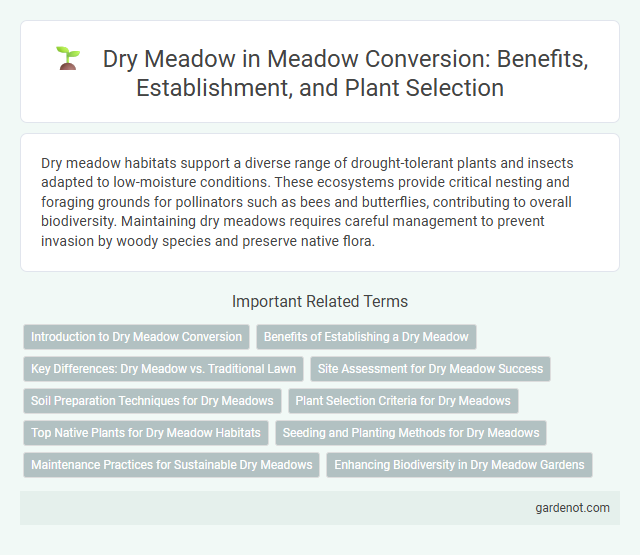Dry meadow habitats support a diverse range of drought-tolerant plants and insects adapted to low-moisture conditions. These ecosystems provide critical nesting and foraging grounds for pollinators such as bees and butterflies, contributing to overall biodiversity. Maintaining dry meadows requires careful management to prevent invasion by woody species and preserve native flora.
Introduction to Dry Meadow Conversion
Dry meadow conversion involves transforming nutrient-poor, well-drained grasslands into diverse ecosystems that support native flora and fauna. This process enhances biodiversity by promoting drought-resistant plant species adapted to low-moisture conditions, improving soil stability and habitat quality. Effective dry meadow conversion requires careful assessment of soil composition, existing vegetation, and climatic factors to ensure sustainable ecological restoration.
Benefits of Establishing a Dry Meadow
Establishing a dry meadow promotes biodiversity by providing habitat for pollinators, native grasses, and drought-tolerant plants, enhancing local ecosystems. Dry meadows improve soil health through natural erosion control and nutrient cycling, reducing the need for irrigation and chemical fertilizers. They also contribute to water conservation by thriving in low-moisture environments, making them an eco-friendly landscaping option in arid regions.
Key Differences: Dry Meadow vs. Traditional Lawn
Dry meadows require significantly less water than traditional lawns, promoting drought resistance and water conservation. Unlike traditional lawns, which need frequent mowing and fertilization, dry meadows support native plants and pollinators while reducing maintenance costs. The soil in dry meadows improves biodiversity and resilience, contrasting with the often compacted and nutrient-depleted soil found in conventional lawns.
Site Assessment for Dry Meadow Success
Site assessment for dry meadow success involves analyzing soil texture, drainage patterns, and native plant species composition to ensure optimal growth conditions. Evaluating sunlight exposure and historical land use helps identify potential challenges such as soil compaction or invasive species presence. Accurate site evaluation enhances plant establishment, biodiversity, and long-term sustainability of dry meadow ecosystems.
Soil Preparation Techniques for Dry Meadows
Effective soil preparation techniques for dry meadows involve thorough site assessment and soil testing to determine nutrient levels and pH balance. Techniques such as deep ripping or aeration improve soil structure and water infiltration, while the incorporation of organic matter enhances moisture retention in sandy or low-fertility soils. Selecting drought-tolerant native grasses and wildflowers further supports ecosystem resilience and reduces maintenance in dry meadow restoration projects.
Plant Selection Criteria for Dry Meadows
Plant selection criteria for dry meadows prioritize drought-tolerant native species that thrive in low-moisture, well-drained soils. Choosing deep-rooted perennials and grasses, such as little bluestem (Schizachyrium scoparium) and purple coneflower (Echinacea purpurea), enhances resilience and supports local biodiversity. Emphasizing plants with seasonal adaptability and minimal irrigation requirements ensures sustainable, low-maintenance meadow ecosystems.
Top Native Plants for Dry Meadow Habitats
Top native plants for dry meadow habitats include Little Bluestem (Schizachyrium scoparium), a drought-tolerant grass providing essential cover and erosion control. Purple Coneflower (Echinacea purpurea) attracts pollinators with vibrant blooms and thrives in well-drained soils typical of dry meadows. Blanket Flower (Gaillardia aristata) offers long-lasting color and supports native bees, making it ideal for sustainable dry meadow restoration.
Seeding and Planting Methods for Dry Meadows
Seeding methods for dry meadows prioritize native drought-tolerant species such as little bluestem (Schizachyrium scoparium), purple coneflower (Echinacea purpurea), and prairie dropseed (Sporobolus heterolepis) to enhance ecological resilience. Techniques include drill seeding and broadcast seeding during early spring or late fall to maximize soil moisture retention and germination rates. Incorporating seed mixes with varied maturities and root depths supports biodiversity and stabilizes soil structure in dry meadow restoration projects.
Maintenance Practices for Sustainable Dry Meadows
Sustainable dry meadow maintenance prioritizes periodic mowing or controlled grazing to prevent woody plant encroachment and preserve native biodiversity. Soil health is supported by minimizing fertilizer use and avoiding irrigation, which helps maintain the natural moisture gradient critical for dry meadow species. Regular invasive species monitoring and removal ensure ecosystem resilience and long-term habitat stability.
Enhancing Biodiversity in Dry Meadow Gardens
Dry meadow gardens provide an ideal habitat for native pollinators like bees and butterflies, supporting a diverse range of plant species adapted to low-water conditions. By incorporating drought-tolerant grasses and wildflowers such as purple coneflower and black-eyed Susan, these gardens promote soil health and prevent erosion. Enhancing biodiversity in dry meadows contributes to ecosystem resilience, benefiting local wildlife and reducing maintenance needs.
Dry meadow Infographic

 gardenot.com
gardenot.com